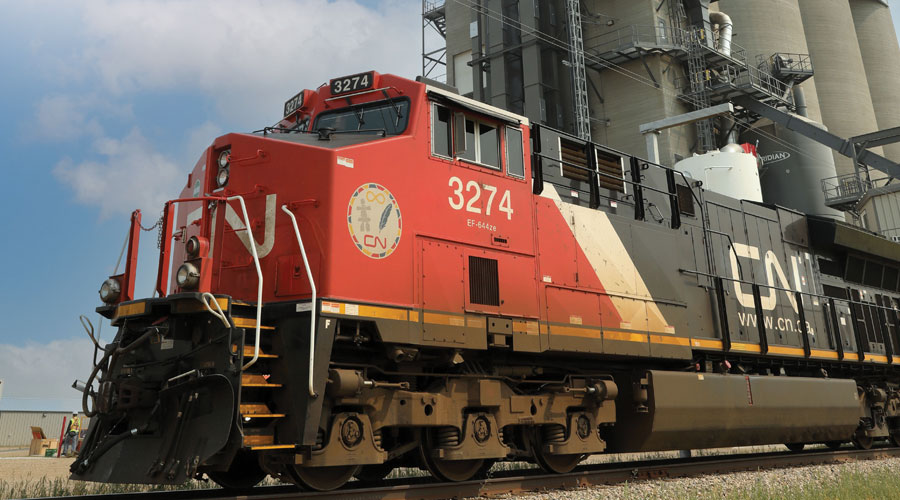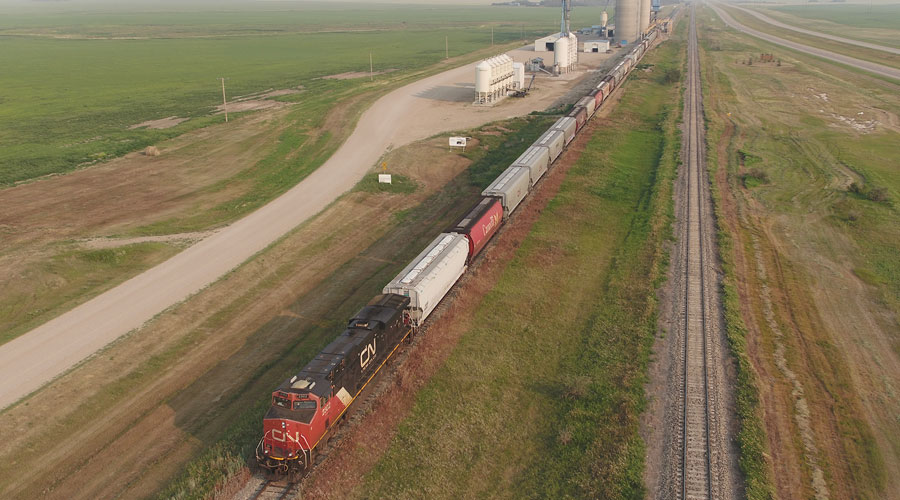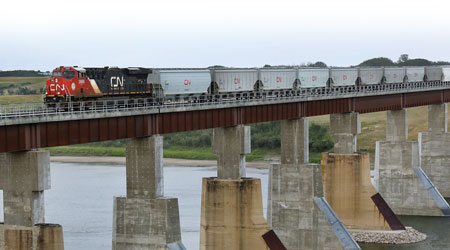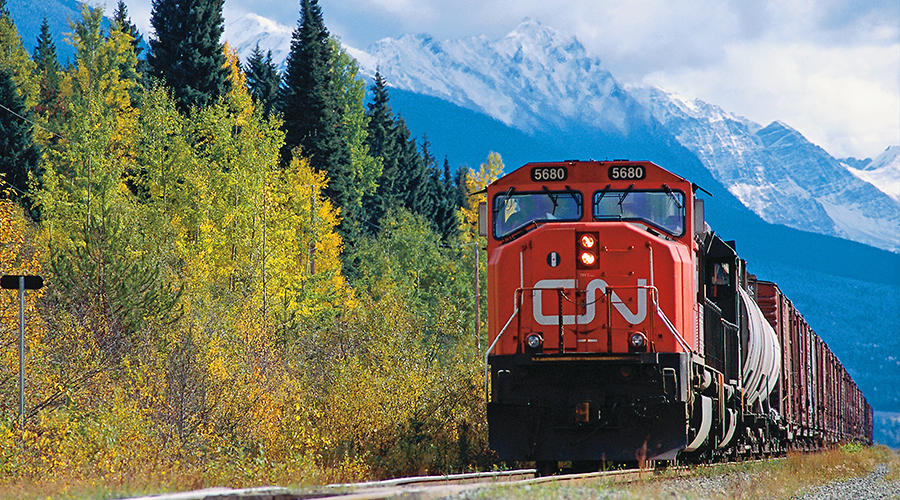Stay updated on news, articles and information for the rail industry
October 2022
Rail News: Shippers
CN forges grain plan to encounter fewer lows, elicit more highs in latest crop year

By Jeff Stagl, Managing Editor
Variability, unpredictability and resiliency. Those are some of the words CN leaders use when describing the promise, performance, headwinds and tailwinds of the railroad’s grain franchise.
Grains are an important commodity for the Class I, generating its third-most annual revenue. In 2021, CN registered CA$2.5 billion in grain revenue, trailing intermodal at CA$4.1 billion and petroleum/chemicals at CA$2.8 billion. The commodity group includes such bulk grains as wheat, oats, corn, rice, barley, flaxseed, peas, soybeans and lentils, and such processed grain products as canola and corn meal, canola oil and malt.
CN provides direct rail access to grain export facilities in Prince Rupert and Vancouver, British Columbia, and Thunder Bay, Ontario; several ports along the St. Lawrence River; and export terminals on the U.S. Gulf Coast. The railroad also offers access to terminals in Duluth, Minnesota, and the delivery of grain/processed grain products to barge-loading facilities along the Mississippi and Illinois rivers.
In general, Canada’s crop year starts Aug. 1 and ends July 31, with corn and soybeans the exceptions stretching from Sept. 1 to Aug. 31. The crop year is much more varied in the United States — for example, the wheat period runs from July 1 to June 30, while the soybean period runs from Sept. 1 to Aug. 31.
Although the grain market historically has been rewarding or taxing to CN many times over the past several decades, the past two crop years have brought the highest of highs and lowest of lows.
In the 2020-21 crop year, grain production in western Canada set a record and CN reached a high-water mark in grain movements. The railroad moved 31 million metric tons (MMT) of Canadian grain, up 1.6 MMT from its previous record set in the 2019–2020 crop year and 2.9 MMT more than the three‑year average.
But in the 2021-22 crop year, a severe drought — Canada’s worst in 20 years — other extreme weather, the pandemic, war in Ukraine, trade pattern shifts, port congestion and container shortages caused a 38% drop in grain production compared with the three-year average.
How extreme was Mother Nature? Widespread floods in southern British Columbia during November 2021 caused 58 outages on CN’s mainline between Kamloops and Vancouver, and a Squamish Subdivision line between Prince George and Vancouver; the prolonged drought led to forest fires in other parts of British Columbia that damaged a CN bridge; and extreme cold, heavy snowfall and blizzard conditions reached lengthy durations and high severity throughout winter at various points on the railroad’s network.
By mid-November, demand for CN‑supplied grain hoppers was roughly half the level reached at the same time during the previous crop year. Demand then fell 40% from February to April 2022. CN moved 18.2 MMT of bulk and processed grain products in the crop year, down 36% compared with the three‑year average.
“The past two crop years were a stark reminder that there is significant variability in crop production potential from one year to the next, as well as regionally within western Canada,” CN officials said in a crop-year summary.
Grain plan’s purpose
Now in the early stages of the 2022-23 crop year, the Class I is trying to ensure it encounters more gains and fewer pains in the grain sector this time around. Although the weather can’t be controlled, there are a number of other factors the railroad has sought to rein in through its 2022-23 Grain Plan.
“We know that there will be predictable events [in the current crop year] that we can plan for and mitigate to the extent possible,” said CN President and CEO Tracy Robinson in the grain plan’s introduction. “A lot can happen over an 18,000‑plus mile rail network over the course of 12 months — we must all keep that in mind when evaluating end‑to‑end supply-chain performance.”
The plan assesses how much grain and processed grain products CN expects to move over the course of the 2022–23 crop year based on available information, including the projected size of the grain crop and other supply‑ and demand‑related estimates. In addition, the document reviews the railroad’s ability to move the anticipated volume of grain over the course of the crop year based on demand forecasts and available resources.
“The plan is all about how we move grain. We constantly consult and review the plan — it isn’t shoved in a drawer and forgotten about,” says CN Assistant Vice President of Grain David Przednowek. “People need to eat, so a lot of grain needs to move.”
During spring and early summer, CN officials consulted with grain customers and other stakeholders concerning the crop year. They also engaged with members of the Agricultural Advisory Council, a cross‑section of industry leaders from across western Canada who provide ongoing advice and feedback on grain transportation and CN’s interaction with producers. CN officials meet with the council quarterly — and other times throughout the year as needed — to review routine planning items.
The discussions helped the Class I predict that the movement of western Canadian grain via carload in the 2022–23 crop year would rebound to between 24.5 and 27 MMT, in addition to grain shipped via container direct from western Canada. Overall, the Canadian grain crop is projected to exceed 70 MMT versus less than 50 million MMT in the 2021-22 crop year.
Opening lines of communication

The various talks also assisted in the development of CN’s grain plan, which outlines initiatives and maneuvers designed to ensure there’s enough capacity and better planning, operations, network productivity and service to handle grain-movement demand.
One such move is the result of complaints from grain customers, who in January expressed frustration with CN’s service disruptions following the British Columbia floods. To improve their ability to plan grain movements, they asked CN to explore ways to improve operational communications and coordination at individual grain terminals.
The railroad now plans to work with grain handlers and exporters during the 2022–23 crop year to improve the two‑way flow of information on car-delivery forecasts and pick-up timing, and loading and unloading schedules at grain terminals.
“Improved short‑ and long‑term customer demand forecasts will support the supply chain’s ability to plan for growth. CN will work with customers’ senior management teams to identify demand forecast enhancements and increase information sharing,” the grain plan states.
On a larger scale, CN is taking a back‑to‑basics approach to its operations to improve velocity and other service measures since grain service performance is tied in large part to overall operating performance. Many changes were implemented in this year’s second and third quarters.
In April, CN stressed that trains departing its four largest rail-car processing yards in Winnipeg, Toronto, Chicago and Memphis operate on time with the correct traffic blocked to destination. In May, the same approach was applied to three smaller car-processing yards that rely on locomotives to move traffic into the correct classification track to be blocked properly to destination.
“Operational adjustments such as these and others are being implemented well in advance of the upcoming harvest and the associated uptick in demand expected with a more normal crop production level,” CN officials said in the grain plan.
In addition, CN’s scheduled grain service model will be counted on as a network efficiency contributor. To maximize grain supply-chain and network efficiency, the railroad uses its serving hubs within the Prairies, its grain corridors and a hub‑and‑spoke model with major terminals in Edmonton and Jasper, Alberta; Melville and Saskatoon, Saskatchewan; and Winnipeg, Manitoba.
The terminals enable CN to operate more than 200 loaded or empty grain cars back and forth from serving hubs to ports to maximize train loads and network capacity.
“The big thing this year is a philosophical change. The new operating plan will help ensure there aren’t less slots for grain,” says CN Chief Marketing Officer Doug MacDonald. “We can fit operations around demand, and turn crews and power better. We will run trains no matter what, and shorten trains accordingly if needed.”
‘Corridor balance is critical’
CN also aims to ensure balance is maintained between loaded traffic moving to destinations and empty car supply returning to origins to ensure corridor fluidity. The railroad’s pipeline management and port operations groups are in daily contact with grain shippers and other railroads to efficiently manage the flow of grain traffic to destinations despite continuously changing vessel arrival times and loading readiness, and weather impacts on terminal productivity.
“Corridor balance is critical, especially with super-charged demand,” says Przednowek. “We want to make sure all corridors are available.”
Capacity is critical for grain movements, too. To that end, CN has concentrated more on the size of the operating crew base and hopper-car and locomotive fleets; the state of infrastructure; and the incorporation of technologies. For now, CN’s annual grain shipment capacity has reached 36 MMT, which is significantly higher than its anticipated grain volume for the 2022–23 crop year.
Based on current demand forecasts, CN officials believe the size of the active operating crew base — predominantly conductors and engineers — will be sufficient to move the anticipated grain volume over the course of the crop year. However, the railroad couldn’t hire and train all the conductors it desired heading into the fourth quarter and demand from all business units likely will exceed the Western Corridor’s capacity at times, so there could be periods during the crop year when short‑term demand isn’t met.
“We think we are in good shape with manpower, save for small pockets in upper British Columbia,” says MacDonald. “We will keep hiring into spring. In Canada, managers can operate trains, so they will help fill in.”
CN also has implemented additional measures to recruit and retain field workers, including improved retention and signing bonuses in hard‑to‑recruit areas; new recruitment information sessions targeted at evenings and weekends; increased participation in employment events such as job fairs; partnerships with post‑secondary educational institutions to improve recruitment of graduates with transferrable skills; and pilot projects aimed at trying new online recruitment and interview tools for critical operational positions.
Meanwhile, the grain hopper fleet is properly sized as well to handle all volume based on projected demand, CN officials say. In fall, the railroad expects to manage an owned/operated/leased fleet of about 11,600 hoppers focused on bulk grain service in western Canada.
In addition, the Class I is continuing a multiyear hopper modernization program and expects to take delivery of 500 high‑efficiency hopper cars during the 2022–23 crop year. Since 2018, CN has acquired 3,000 new-generation, high‑efficiency hoppers, including 500 that were delivered during the 2021–22 crop year. At more than 5,400 cubic feet, the cars’ increased capacity means more tonnage of lighter-density commodities such as canola, barley and oats can be loaded before the cars reach their maximum permissible gross weight, CN officials say.
Motive-power maneuvers

As for locomotives, the fleet of 1,950 units is suitable for grain movements in the 2022–23 crop year, they believe. CN recently ordered 57 high‑horsepower locomotives, of which 47 are expected to be operating on the network in fall and the remaining 10 units are slated for delivery in first-quarter 2023.
CN also acquired 75 high‑horsepower and 13 low‑horsepower locomotives from the secondary market in 2021 and Q1 2022, and recently undertook a modernization program involving 100 locomotives between 25 and 30 years old. The locomotives will be upgraded from DC‑ to AC‑traction motors and equipped with several state‑of‑the‑art technologies to improve productivity and reliability.
Meanwhile, CN has invested millions of dollars and a lot of sweat equity in improving infrastructure to better support grain and other movements. This year, the Class I has budgeted about CA$1.1 billion for track maintenance work and capacity enhancements.
The maintenance work involves replacing 191 miles of rail and 425,000 ties, and rebuilding about 130 grade crossing surfaces. Major capital improvement projects include upgrading rail between Humboldt and Melfort, Saskatchewan, to a 286,000‑pound gross-weight restriction; building 9 miles of double track east of Edmonton; constructing 17 miles of double track in two separate sections west of Edmonton; and creating four 12,000-foot sidings in the Ashcroft, Skeena and Telkwa subdivisions to accommodate more frequent passing trains and increase throughput.
Having enough double track is key in Edmonton, which “is ground zero for grain,” says Przednowek.
CN also is pursuing several multi‑year capital projects focused on removing bottlenecks and creating new capacity in areas near the ports in Prince Rupert and Vancouver.
Ongoing Vancouver projects include the construction of a 13,700‑foot track parallel to an existing mainline in the New Westminster Subdivision; and the completion of the last section of single track (3.7 miles) in the 25‑mile double-track corridor between the end of a CN/CP directional running zone and CN’s Thornton Yard to increase corridor capacity and make the network more resilient.
Ongoing Prince Rupert projects include replacing a bridge, building double track to increase the maximum number of trains that can enter and depart the port daily; and building a road between the Fairview Container Terminal and Ridley Island to enable container-carrying trucks to move more efficiently and support future infrastructure growth.
Eye on innovations
CN leaders also believe technology can help boost capacity and create a more fluid and reliable railroad. Technological investments can assist the Class I in identifying problems before they become more serious, such as a wheel breaking.
Two major technological innovations CN has implemented of late are an automated track inspection program (ATIP) and automated inspection portals. Until recently, the primary means of track inspection was by a track inspector in a hi‑rail vehicle moving at speeds of 15 mph to 20 mph along track, with stops along a route for visual inspections. During that time, a track is unavailable for freight movements.
Now, CN has 10 specialized ATIP track inspection cars moving in its network. The cars are equipped with the latest sensor and artificial intelligence technology to fully automate inspections.
“Defect detection is important,” says Przednowek.
It’s vital to find any ice jacking — the buildup of snow and ice between tie plate rail seats and the underside of a rail base — which can cause service disruptions in winter, he says.
“We will have third-generation cars to help detect that,” says Przednowek.
The book on winter
Another tool designed to help CN deal with weather effects from December to March: its annual winter plan. The Class I released its 2022-23 Winter Plan on Oct. 3.
The plan is the result of broad consultations and close collaboration with various shippers and stakeholders. It outlines the operating challenges CN expects to face during the Canadian winter; describes the lessons learned in past winters; and identifies the actions and innovations implemented to help maintain operations through the difficult weather period.
Similar to the grain plan, the winter plan describes moves the railroad is making or plans to make regarding rolling stock, infrastructure, capacity, operations and technology.
The last two winters show how drastically different that season can be, says Przednowek.
“Two years ago, it didn’t even feel like winter in December and January. But last winter was very trying,” he says.
The weather is the biggest wild card with grain-movement planning, says MacDonald.
“If it’s a normal winter, we are well situated for it. We are sized up,” he says. “We will see how the new operating plan goes. At least we are willing to try it.”
This early in the 2022-23 crop year, CN already is at maximum grain orders. It’ll be good to move that freight now before winter arrives, MacDonald says.
While the last crop year “was a crapshoot” with little clarity on grain market factors, there is no such murkiness so far in the current crop year, he says.
CN is poised to ship up to 7,800 cars of grain and processed grain products weekly before winter, and up to 6,250 cars weekly during winter, assuming conditions are mostly favorable.
“We are in a better position this year. Now, we can focus in on what we know,” says MacDonald. “We feel good about the position we’re in.”
CN leader Robinson agrees.
“Heading into fall, we are confident that the adjustments we have made to our operations and planning activities, combined with the investments [we’ve] made with an eye to future economic growth, will deliver a strong 2022–23 grain plan and produce results for western Canadian agriculture,” she wrote in the plan’s introduction.
Email questions or comments to jeff.stagl@tradepress.com.


 2025 MOW Spending Report: Passenger-rail programs
2025 MOW Spending Report: Passenger-rail programs
 Gardner steps down as Amtrak CEO
Gardner steps down as Amtrak CEO
 Guest comment: Oliver Wyman’s David Hunt
Guest comment: Oliver Wyman’s David Hunt
 Women of Influence in Rail eBook
Women of Influence in Rail eBook
 railPrime
railPrime






